We aim to be client-centred. We suggest breaking projects into stages in order to provide natural break points where you have the final say as to whether and how we proceed. For time-critical projects we will email progress summaries at the end of each week.
A typical project scope includes some or all of the following stages:
- Definition of requirements/specifications
- Design concept generation, review and selection. Includes review of candidate manufacturing processes.
- Detailed design generation of component, tooling, fittings and test fixtures. Detailed analyses including finite element analyses are performed at this stage.
- Manufacture of one or more prototypes
- Testing of prototypes, which may include the following static or cyclic loads: hydrostatic pressure, tension, compression, torsion, bending, vibration, heat and electrical
- Component redesign if necessary
- Component manufacture
Our core capability is filament winding.
Filament Winding: Resin-impregnated filaments are drawn onto a rotating mandrel. They are laid precisely layer by layer in pre-determined patterns, usually by computer-controlled machinery.
The filaments: These give strength and stiffness to the composite material. They are usually made from glass, carbon or graphite; more rarely aramid, polyethylene, boron, basalt etc. The filaments are very fine - approximately 7 micrometres for carbon fibres and 24 micrometres for glass fibres. Thousands of continuous filaments are bundled into "tows" or "rovings".
Resins: These are typically liquid epoxy, vinyl ester, polyester or phenolic resins mixed with hardeners, air release agents and other additives. Their main purpose is to Keep the filaments in position, distribute loads to the filaments and protect the filaments
Mandrels: These form the internal surface of the filament wound part. They usually have circular cross-sections, such as pipes, pressure vessels and golf shafts. Other shapes can be wound, however. They can be made from many materials such as steel, aluminium, foam, wood or plaster. They can be monolithic (extracted in one piece), multi-part, collapsible, frangible or soluble depending on the shape of the part. They are usually coated with a release agent to prevent resin adhesion.
Advantages of filament winding:
- Ideal for simple parts requiring maximum performance (strength- or stiffness-to weight ratio) such as rocket motor cases, pressure vessels, pipes, tubes, spars, submarine hulls, driveshafts and high-speed rollers
- Usually cheaper than all composite manufacturing processes except for pultrusion for reasonable production runs
- Precise – parts are manufactured almost exactly as designed (compare simulation and photograph on right)
- Consistent – there is very little part-to-part variation so design margins can be reduced
- The use of continuous filaments optimally oriented under tension can yield extremely high performance designs
- Features can be combined to reduce the number of joints
- Autoclave costs can usually be avoided
- The process uses raw materials in their cheapest state (unless tapes or pre-impregnated tows are used)
- Productivity can be increased by adding spindles and winding more than one part at a time
Disadvantages:
- Poor external surface quality, unless external moulds or tapes are used
- Expensive for short runs
- Higher void content than autoclave-cured parts
- Some shapes are difficult to wind - especially those with concave surfaces or features that would intersect the fibre delivery path
- It is difficult to lay fibres axially, which is desirable for maximum bending or axial strength and stiffness. The lowest practical winding angle is about 10 degrees from the meridian of the mandrel, which entails a small performance deficit.
Representative applications of filament winding:
- Pressure vessels
- Pipes for corrosive environments
- Irrigation pipes
- Chemical tanks
- Driveshafts
- Freight tanks
- High speed rollers
- Ducts
- Pontoons
- Buoys
- Fishing rods
- Tent poles
- Boat masts
- Power poles
- Golf clubs
- Springs
- Ladders
- Printed circuit forms
- Commutators
- Rocket fuel tanks
- Solid propellant rocket casings
- Rocket nozzles
- Heat shields
- Aircraft cowlings
- Submarine hulls
- Sub-sea pipes
- Aircraft fuel tanks
- Radomes
- Spacecraft structures
- Gas bottles
|
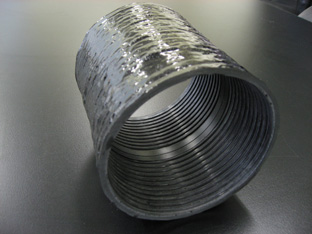
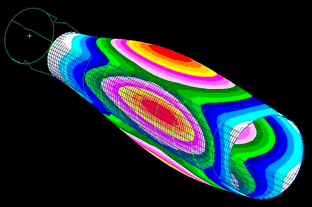
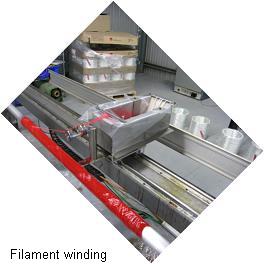
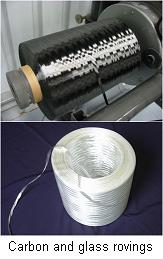
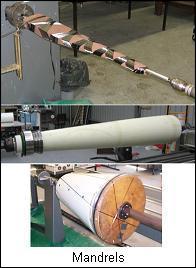

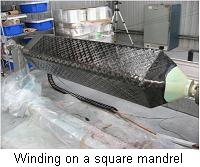
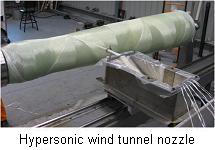
|









